Nikkei and FTSE Show Promise
By Colin Twiggs
February 24, 2007 1.00 a.m. ET (5:00 p.m. AET)
These extracts from my daily trading diary are for educational purposes and should not be interpreted as investment advice. Full terms and conditions can be found at Terms of Use.
USA: Dow, Nasdaq and S&P500
The Dow Jones Industrial Average has passed its target of 12500 (11600+[11600-10700]). Twiggs Money Flow (21-day) signals short-term accumulation, but displays a long-term bearish divergence, warning of a possible secondary correction. This is not a good time to enter the rally (of the last 8 months) as it is already extended.
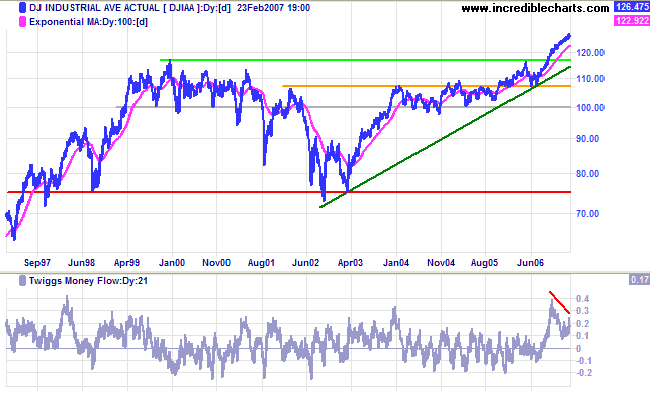
Long Term: The primary trend is up. Support is at the previous high of 11600/11650 and at the previous low of 10700.
Short Term: Declining volume warns that buyers are losing enthusiasm. Reversal above 12700 would signal another rally, while a fall below support at 12550 would warn of a secondary correction.
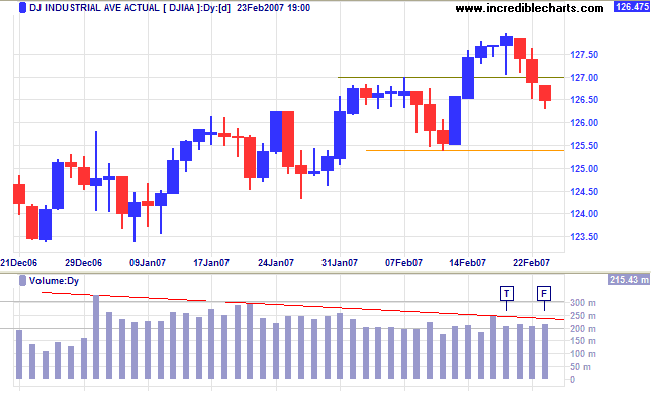
Fedex has followed the Dow Jones Transportation Average to a new high, but UPS is still malingering. Both stocks in strong up-trends would signal improving economic activity.

The Nasdaq Composite broke through the psycholigical
barrier of 2500, signaling continuation of the up-trend -- with
a target of 2800 [ 2400 + ( 2400 - 2000)].
Long Term: The index remains a long way below its
previous high of 5000, but is in a healthy up-trend. Support is
at the earlier high of 2400 and the preceding low of 2000.
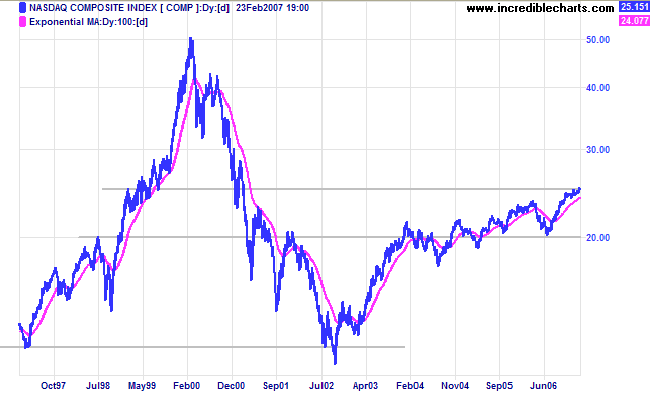
Having passed its target of 1430 ( 1325 + [ 1325 - 1220 ]) the S&P 500 is headed for a test of its former high of 1500. Expect strong resistance. Probability of a secondary correction (or large consolidation) is increasing as the rally has extended a long way from its base. Twiggs Money Flow (21-day) shows short-term accumulation, but a long-term bearish divergence.
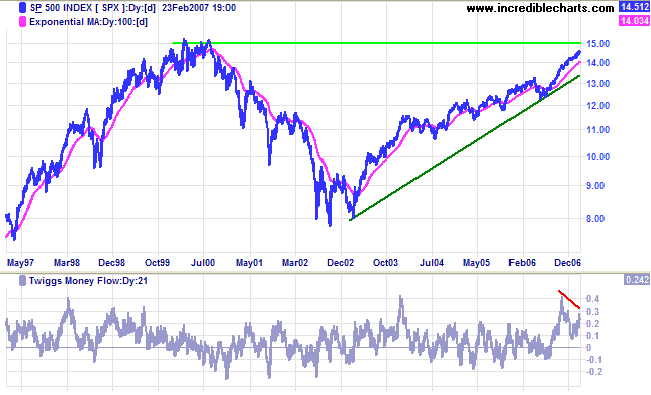
LSE: United Kingdom
The FTSE 100 is in a strong up-trend, with a target
close to the 1999/2000 highs of 6800/6900 (6100 + [6100 - 5500]
= 6700 ).
Twiggs Money Flow (21-day) signals short-term accumulation,
rising sharply above the zero line.
Long Term: The primary up-trend continues, with support
at the preceding high of 6000/6100 and the preceding low of
5500.
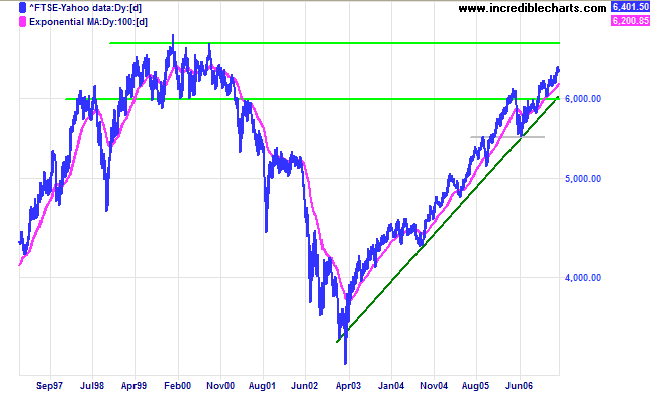
Nikkei: Japan
The Nikkei 225 is rallying strongly, breaking through
resistance at 18000 after a narrow consolidation.
Twiggs Money Flow (21-day) signals long-term accumulation,
holding well above zero over the past 3 months. Target for the
breakout is the next major resistance level of 21000 [ 17600 +
( 17600 - 14200 )].
Long Term: The primary trend is up, with support at the
preceding high of 17500/17600 and at the preceding low of
14200.
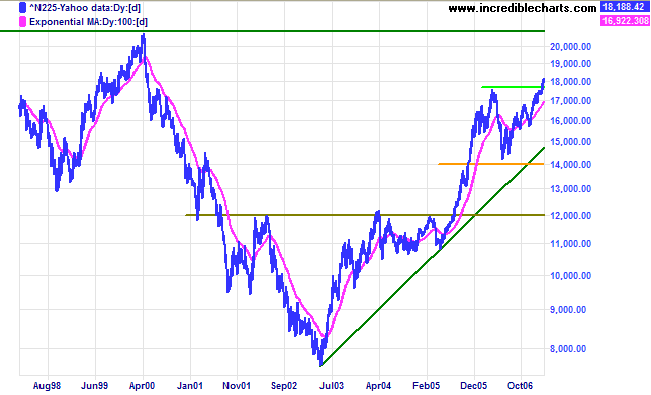
ASX: Australia
The All Ordinaries is testing resistance at the
psychological barrier of 6000; well past its target of 5800
[5300 + (5300-4800)] and above the upper border of the trend
channel (drawn at 2 standard deviations around a linear
regression line). Probability of a secondary correction is
increasing. The sharp reversal on
Twiggs Money Flow (21-day) over the past few days indicates
sizeable profit-taking. The rally (of the last 8 months) is too
extended for this to be a good time to enter.
Long Term: The primary trend is up, with support at 5300
(the preceding high) and 4800 (preceding low).
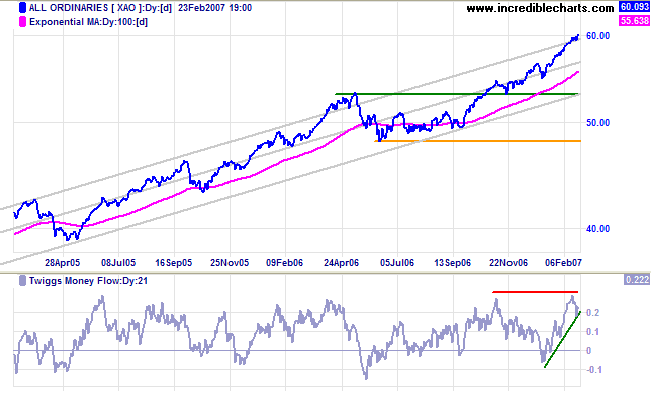
Short Term: narrow consolidation below 6000 is a bullish sign, but unusually high volume in the last two days and a weak close on Friday signal strong resistance. A rapid surge above 6000 would indicate that we are close to a blow-off, while consolidation or a retracement would restore some measure of stability.
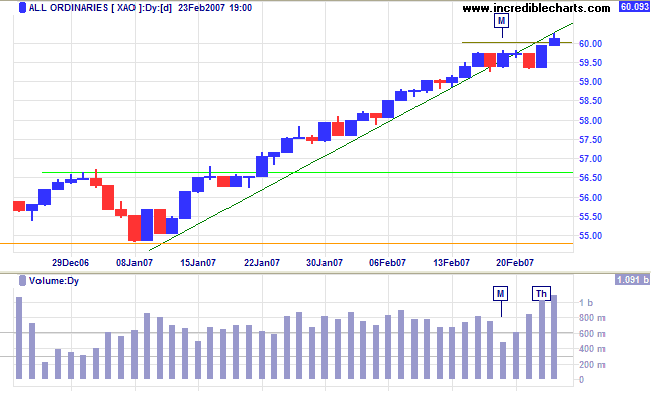
Prudent, cautious self-control is wisdom's root.
~ Robert Burns
|
Technical Analysis and Predictions I believe that Technical Analysis should not be used to make predictions because we never know the outcome of a particular pattern or series of events with 100 per cent certainty. The best that we can hope to achieve is a probability of around 80 per cent for any particular outcome: something unexpected will occur at least one in five times. My approach is to assign probabilities to each possible outcome. Assigning actual percentages would imply a degree of precision which, most of the time, is unachievable. Terms used are more general: "this is a strong signal"; "this is likely"; "expect this to follow"; "this is less likely to occur"; "this is unlikely"; and so on. Bear in mind that there are times, especially when the market is in equilibrium, when we may face several scenarios with fairly even probabilities. Analysis is also separated into three time frames: short, medium and long-term. While one time frame may be clear, another could be uncertain. Obviously, we have the greatest chance of success when all three time frames are clear. The market is a dynamic system. I often compare trading to a military operation, not because of its' oppositional nature, but because of the complexity, the continual uncertainty created by conflicting intelligence and the element of chance that can disrupt even the best made plans. Prepare thoroughly, but allow for the unexpected. The formula is simple: trade when probabilities are in your favor; apply proper risk (money) management; and you will succeed. For further background, please read About The Trading Diary. |

Author: Colin Twiggs is a former investment banker with almost 40 years of experience in financial markets. He co-founded Incredible Charts and writes the popular Trading Diary and Patient Investor newsletters.
Using a top-down approach, Colin identifies key macro trends in the global economy before evaluating selected opportunities using a combination of fundamental and technical analysis.
Focusing on interest rates and financial market liquidity as primary drivers of the economic cycle, he warned of the 2008/2009 and 2020 bear markets well ahead of actual events.
He founded PVT Capital (AFSL No. 546090) in May 2023, which offers investment strategy and advice to wholesale clients.
